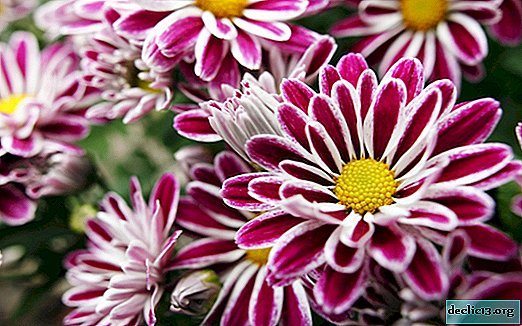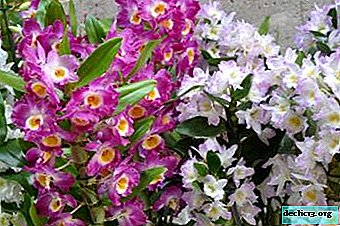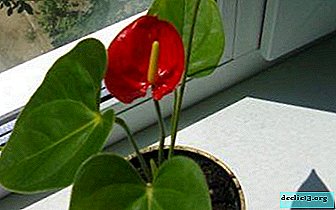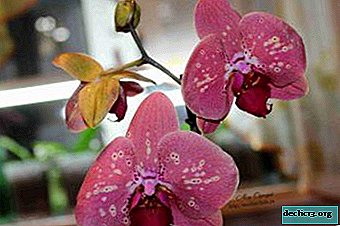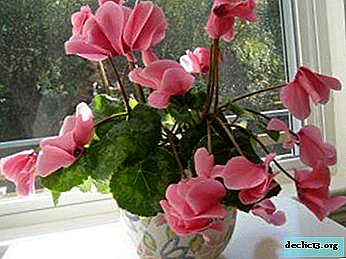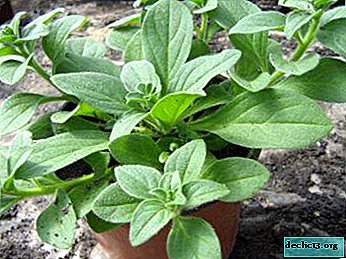What are the diseases and pests of petunia? Methods of dealing with them
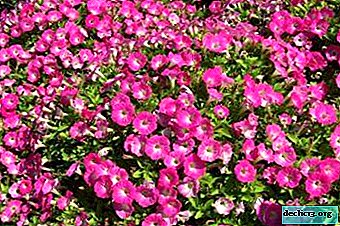 Petunia is a beautiful ornamental plant that can be grown both on the street and in the house. Differs in magnificent and bright blossoming, and also not pickiness in the plan of leaving.
Petunia is a beautiful ornamental plant that can be grown both on the street and in the house. Differs in magnificent and bright blossoming, and also not pickiness in the plan of leaving.
But this is not a reason to abandon the plant and look after it poorly. Otherwise, petunia will begin to hurt or it will be affected by pests, which will ultimately lead to the death of the flower.
So, from the article you will learn what diseases and pests can affect the flower, as well as how to deal with them.
Diseases
Petunia is a hardy plant, despite its unpretentiousness. But there are situations when it affects the disease. Most often it is fungal or infectious. They are very difficult to treat, so it is better to take preventive measures in advance and prevent the development of an unpleasant process.
Blackleg
This ailment is common. It can be recognized by a dark and soft stalk. The reason for this may be a dense landing of petunias, moist air or soil with an acid reaction. The black leg is not treated. The affected plant is thrown away.
Important! Only at the initial stage of the disease can you try drugs based on oxadiccyl, metalxil or mancozeb.Gray rot
This disease occurs with insufficient or excessive introduction of nitrogen into the soil, excessive humidity of air and earth. The culprit of the pathology is the fungus that lives in the ground. It seeps through the roots and defeats the entire terrestrial part of the flower.
You can recognize the ailment by such symptoms as spots on the leaves and branches. In appearance, they resemble a rash. Then the spots are dried, and a gray coating remains on the surface of the leaves. Medicines such as Integral and Skor will help defeat the disease..
Brown spotting
Under conditions of increased humidity of air and soil, brown spotting occurs. It can be detected by the presence of brown spots on the leaves of petunias. The main reason is stagnation of excess moisture. To combat the disease, a copper-based drug is used. Processing is carried out 2-3 times with an interval of 7-10 days.
Powdery mildew
Due to sudden changes in temperature, excess moisture or lack of light, powdery mildew occurs on petunia bushes. It can be recognized by white plaque, which covers the leaves and stems of the culture. During treatment, remove the affected parts of the plant, remove the topsoil remaining to be disinfected, and treat the plantings with Topaz or Fundazole chemicals.
Read more about how to deal with powdery mildew on petunias, read here.
Chlorosis
 Chlorosis is not a disease, but rather the result of improper care. Initially, the leaves become light, and light spots form on the flowers. After the growth of the plant stops, and in severe cases, petunia dies.
Chlorosis is not a disease, but rather the result of improper care. Initially, the leaves become light, and light spots form on the flowers. After the growth of the plant stops, and in severe cases, petunia dies.
The danger of chlorosis is that the plant after it is difficult to recover, retains an oppressed appearance for a long time and can die. So proceed to treatment immediately after the lesion is detected. What is the treatment for chlorosis? For this, flower growers use a home-made composition obtained from 7.5 g of copper sulfate and 12 g of citric acid. The solution turns light yellow. Take 1 tsp. solution and combine with 3 l of water. Watering is done under the root.
Attention! Treatment measures should be carried out every 2 days for 7 days.You can learn more about why petunia leaves lighten and whiten in this article.
Why do flowers stretch out?
Very often, petunia is stretched even before the first leaves are formed. The main reasons can affect this:
- high or low temperature;
- low humidity;
- lack of light;
- growing petunias in containers with high edges.
What to do if the petunia is extended? At the initial stage, it is necessary to create full-fledged microclimate conditions, and also to pick the plants in separate containers. In addition, the following recommendations will help:
- with the formation of cotyledonous leaves, reduce temperature indicators to 20 degrees of heat;
- when the first leaf appears, increase the daylight hours to 8 hours;
- during this period, top dressing in the form of a complex fertilizer that contains calcium for rooting the flower;
- after picking plants, lower temperature indicators to 16-18 degrees of heat;
- daylight should be as long as possible for pickled seedlings.
Photo
Next, you can see photos of diseased plants and pests on them:



Treatment
Folk remedies
From fungus
How to treat fungal diseases of petunia folk remedies? To do this, you can try the following recipes:
- Combine 20 g of soda ash and 5 g of dishwashing detergent. Dissolve in 5 l of hot water. Spray petunia and soil with a cooled solution.
- Pour 30 g of chopped garlic into 1 liter of water. Wait 1 day, filter and apply for spraying.
- Pour 40 g of mustard powder into 10 liters of water. Ready solution to spray a plant.
- Pour 100 g of horsetail 1 liter of water. Wait 1 day. Boil the mixture for 2 hours over low heat, cool and filter. Pour into a container with a spray, pre-connecting with water 1: 5, and treat the petunia every day.
- Dilute the serum with water in a ratio of 1:10. Use the resulting product for spraying. The solution forms a film on the leaves and stems, which complicates the respiration of the mycelium. In addition, the culture itself receives useful substances and heals. Treat petunias in dry weather, 3 times with an interval of 3 days.
- Take 100 g of horsetail, pour 1 liter of boiling water. Leave for 1 day. Then set on fire and simmer for 1-2 hours. Filter, cool and dilute with water (1: 5). Apply for spraying bushes. Carry out the treatment regularly, since the solution creates protection against powdery mildew. For treatment, it is enough 3-4 times a day with an interval of 5 days.
From pests
The following folk recipes remain effective for dealing with them.:
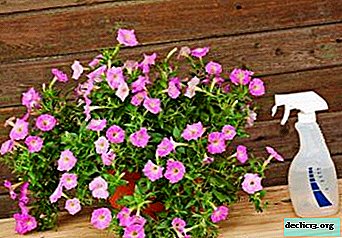 Combine in equal proportions liquid soap and water. Spray the plant every other day for 3-4 days.
Combine in equal proportions liquid soap and water. Spray the plant every other day for 3-4 days.- Tear off the leaves of tomatoes, put them in a bucket, fill with water (1: 1), leave for 2 hours, filter and use for spraying.
- Take 20 g of soap, 3 cloves of garlic, 500 ml of water and 5 ml of vegetable oil. Combine all components, and use the resulting solution to spray a bush of petunia.
- Take the tops of potatoes and water in a proportion of 50:50, add 50 g of liquid soap. Apply for spraying.
- 500 g of tobacco, 50 ml of liquid soap. Dissolve everything in 10 l of hot water. Wait for the solution to cool, filter and proceed with processing.
Medical preparations
The following drugs can be used to combat pests of petunias and diseases:
- Aktara. The role of the main component is thiamethox. It is characterized by an improved mechanism of action and eliminates all parasites completely. To prepare the solution, take 2 liters of water and 600 ml of the drug. Spray the plant, and reuse the drug after 10 days.
- Confidor. This is a contact-intestinal insecticide with a wide range of effects. It can be used for soil treatment and spraying the flower. effective against many pests. To prepare the solution, take 10 l of water and dissolve 1 g of the drug.
- Coming soon. This fungicide, which is effective against scab powdery mildew, gray rot, spotting. To prepare the solution, take 10 liters of water and 2 ml of the drug. Processing 3 times with an interval of 20 days.
- Maksim. This drug, in which fludioxonil acts as the active substance. It is used to combat rot, fusarium wilt. To prepare the solution, take 4 ml of the drug and dilute in 2 liters of water.
How to treat from insects?
- Whiteflies. These are small insects that cannot be overlooked. It is enough to touch the flower, as a large number of midges will fly out from there. In addition, the flowers begin to turn yellow and fade. To combat insects use Confidor and Actelik preparations.
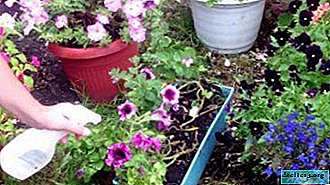 Aphid. These pests are one of the most common. To determine their presence, you just need to look at the bush: clusters of aphids cover the stem and leaves with a dense layer. As a result of this, they are twisted and deformed. For the fight using such drugs: Decis, Confidor and Actara.
Aphid. These pests are one of the most common. To determine their presence, you just need to look at the bush: clusters of aphids cover the stem and leaves with a dense layer. As a result of this, they are twisted and deformed. For the fight using such drugs: Decis, Confidor and Actara.- Spider mites. These insects do a lot of harm to petunias. During their invasion, a general oppression of the plant occurs and a thin web is present near them. To combat the spider mite, Demitna, Appolo, Neoron are used. When processing the flower, make sure that the solution gets on the inside of the leaf plate.
Why do plants disappear and what to do?
There are situations when a young petunia begins to die, before it even has time to bloom, the reasons why this happens:
- Lack of moisture and fresh air. It is necessary to regularly air the room where the flower is located.
- Blackleg. This is a dangerous fungus that often infects petunia seedlings. It will not be possible to save the plant, so you will have to get rid of it.
- Yellowing seedlings. This is an alarming symptom that requires urgent action, otherwise the flower will die. The cause of yellowness remains chlorosis, or rather lack of iron. To solve the problem, feed petunia with iron-based preparations and do not moisten the soil very much.
- Dense landing. Because of this, there is little space for plants; they lack fully nutrients, sunlight. It is necessary to transplant them into a larger container, and after a few days, fertilize with boron and phosphorus.
- Pests. When invaded by parasites, petunia can die. Most often, pests affect those plants that are grown in a greenhouse. A flower suffers from thrips, aphids, and whiteflies. These parasites can be recognized if you carefully monitor young plants.
How to revive?
If the petunia began to fade, her leaves drooped, then urgent measures must be taken to save it. Procedure for resuscitating a flower:
- Trim all remaining bushes to the ground, leaving only a few leaves.
- Take a pot and sprinkle earth, a little egg shell.
- Plant petunia and water well with a solution of Energen.
- Install the pot in the room on the floor or on the balcony for 4 days.
- After 2 weeks, the plants will begin to come to life and grow.
Potassium
 When fertilizing petunias, potassium-based preparations must be used. The fact is that this microelement has a positive effect not only on the growth and development of the plant, but also on flowering. This allows you to get lush buds that will delight you with their beauty for a long time.
When fertilizing petunias, potassium-based preparations must be used. The fact is that this microelement has a positive effect not only on the growth and development of the plant, but also on flowering. This allows you to get lush buds that will delight you with their beauty for a long time.
Introduce potassium after the petunia has been transplanted to a permanent place. After 10-14 days, you can make the first feedingusing potassium monophosphate (5 g per 10 l of water).
Advice! Diseases and pests infect petunias not so often if the grower pays due attention to this flower. And for this you need not only to fully care for him, but also to carry out preventive treatment on time.
 Combine in equal proportions liquid soap and water. Spray the plant every other day for 3-4 days.
Combine in equal proportions liquid soap and water. Spray the plant every other day for 3-4 days. Aphid. These pests are one of the most common. To determine their presence, you just need to look at the bush: clusters of aphids cover the stem and leaves with a dense layer. As a result of this, they are twisted and deformed. For the fight using such drugs: Decis, Confidor and Actara.
Aphid. These pests are one of the most common. To determine their presence, you just need to look at the bush: clusters of aphids cover the stem and leaves with a dense layer. As a result of this, they are twisted and deformed. For the fight using such drugs: Decis, Confidor and Actara.
